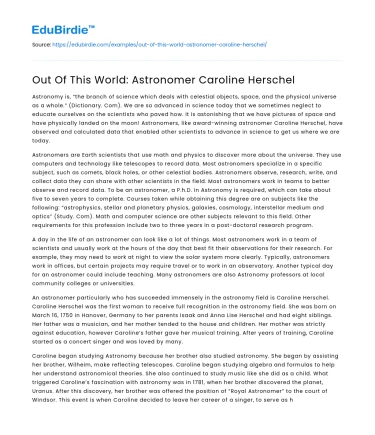Astronomy is, “the branch of science which deals with celestial objects, space, and the physical universe as a whole.” (Dictionary. Com). We are so advanced in science today that we sometimes neglect to educate ourselves on the scientists who paved how. It is astonishing that we have pictures of space and have physically landed on the moon! Astronomers, like award-winning astronomer Caroline Herschel, have observed and calculated data that enabled other scientists to advance in science to get us where we are today.
Astronomers are Earth scientists that use math and physics to discover more about the universe. They use computers and technology like telescopes to record data. Most astronomers specialize in a specific subject, such as comets, black holes, or other celestial bodies. Astronomers observe, research, write, and collect data they can share with other scientists in the field. Most astronomers work in teams to better observe and record data. To be an astronomer, a P.h.D. in Astronomy is required, which can take about five to seven years to complete. Courses taken while obtaining this degree are on subjects like the following: “astrophysics, stellar and planetary physics, galaxies, cosmology, interstellar medium and optics” (Study. Com). Math and computer science are other subjects relevant to this field. Other requirements for this profession include two to three years in a post-doctoral research program.
Save your time!
We can take care of your essay
- Proper editing and formatting
- Free revision, title page, and bibliography
- Flexible prices and money-back guarantee
A day in the life of an astronomer can look like a lot of things. Most astronomers work in a team of scientists and usually work at the hours of the day that best fit their observations for their research. For example, they may need to work at night to view the solar system more clearly. Typically, astronomers work in offices, but certain projects may require travel or to work in an observatory. Another typical day for an astronomer could include teaching. Many astronomers are also Astronomy professors at local community colleges or universities.
An astronomer particularly who has succeeded immensely in the astronomy field is Caroline Herschel. Caroline Herschel was the first woman to receive full recognition in the astronomy field. She was born on March 16, 1750 in Hanover, Germany to her parents Isaak and Anna Lise Herschel and had eight siblings. Her father was a musician, and her mother tended to the house and children. Her mother was strictly against education, however Caroline’s father gave her musical training. After years of training, Caroline started as a concert singer and was loved by many.
Caroline began studying Astronomy because her brother also studied astronomy. She began by assisting her brother, Wilheim, make reflecting telescopes. Caroline began studying algebra and formulas to help her understand astronomical theories. She also continued to study music like she did as a child. What triggered Caroline’s fascination with astronomy was in 1781, when her brother discovered the planet, Uranus. After this discovery, her brother was offered the position of “Royal Astronomer” to the court of Windsor. This event is when Caroline decided to leave her career of a singer, to serve as her brother’s assistant in Bath, England, England. Her salary was fifty pounds a year the first salary to a woman for scientific work.
A typical day in the life for Caroline was studying algebra and physics. She also spent many of her time mapping star clusters, comets, and nebulae. She noted all the research and calculations her and brother completed. Caroline kept herself busy daily with learning new math and physics formulas to better understand the astronomical research they were conducting.
Upon starting her own astronomical research, Caroline began to specialize in comets. She discovered eight comets and fourteen nebulae. Nebulae are interstellar clouds of stars.“Stars and solar systems form in giant interstellar clouds called nebulae” (GotBooks MiraCosta). Thanks to Caroline, we can look into a telescope and see all the comets and nebulae we did not know were there. The first comet Caroline discovered was Comet Herschel. She discovered Comet Herschel with a telescope her brother gifted her. Caroline held the title of most comets discovered by a woman until the year 1980. Caroline and her brother built a telescope and noted the positions of stars. She became the highest paid assistant for her continuous discoveries. Another accomplishment is the supplemental catalog for Famseeds Atlas for star clusters and nebular patches that contained over five hundred sixty-one stars including an index. In her lifetime, Caroline published many of her writings and charts of stars, nebulae, and comets.
After Caroline’s brother died in 1822, she moved back to her hometown of Hanover, Germany. She continued writing and studying. For her contributions in the astronomy field, she was awarded with many different achievements. Her awards include the following: “1828 the gold medal of the Royal Astronomical Society,1838 the Royal Irish Academy of Sciences in Dublin appointed her to its number, and the gold medal of the Prussian Academy of Sciences.” (Schroder).
Caroline Herschel is relevant to this Earth Science course because without her, we would not have most of the knowledge we currently do about our solar system. In this course, we learned about the solar system and briefly discussed comets. We read in our textbook about what stars and what nebulae are and how they are formed in our solar system. Caroline’s intelligence and discovered many other women to work in the sciences.Thanks to Caroline Herschel, we are able to observe and learn about the solar system through her assistance in the production






 Stuck on your essay?
Stuck on your essay?

